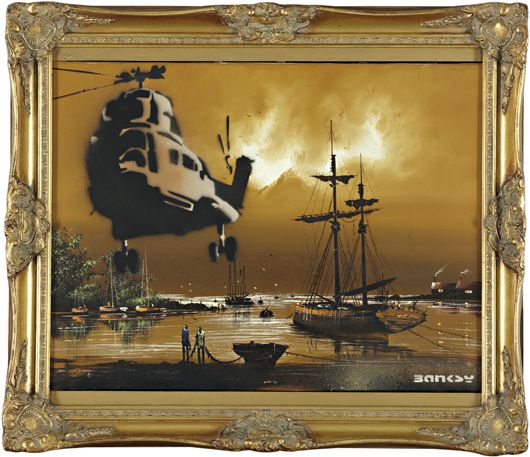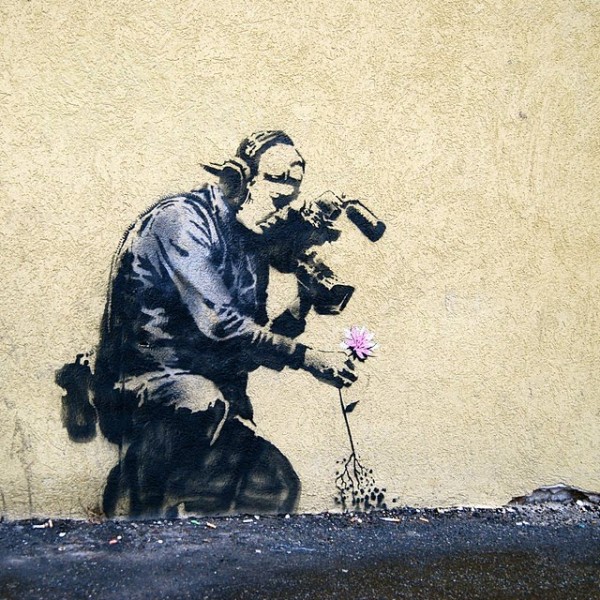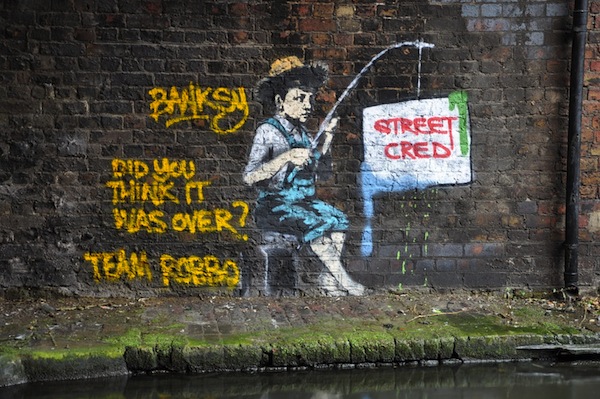Original post on Juxtapoz here
It seems as though Banksy has truly done it again. When it seems like he has exhausted his long list of issues to take shots at, there is always one more trick up his wry sleeve. There is not a single member of the street art community that I can think of that has so brazenly challenged its aggressive and cantankerous older brother, graffiti. And for good reason, considering the retribution for going over any writer is not worth the effort or the pain. Instead, artists who do not define themselves as writers, or frankly take on the kind of risk and responsibility of writers, are relegated to primarily street art or virgin spots. It seems that wheatpaste has only grazed (or maybe graced) a throwup or old school piece out of ignorance, not as a provocation; most notably Shepherd Fairey’s encounter with Marty, and the whole DYM incident revolving around Jace and 11 spring (of course there are even some personal anecdotes that I won’t go into.) In all of the countless cases in which street art has stepped on writers’ toes, the transgressions have warranted outcries, apologies, and even formal letters of justification.
But here we have Street Art’s most celebrated figure actually instrumentalizing an old school piece and incorporating it into the work UNapologetically. This is not a situation of callous poster application and graff forum howling, which is undoubtedly followed by a lauded takeback. Instead, Banksy scoped the spot, made the effort to cross the canal, and then turned a 24 year old piece into wallpaper, which despite being the ultimate offense, poses some interesting considerations. Firstly, instead of succumbing to graffiti’s belligerence, Banksy confronted and subverted its methods. In a satirical statement, we see the old school converted into figurative wall paper (while of course it is still paint). Robbo actually becomes controversial wheatpaste, the very medium that is so loathsome to aerosol, and in doing so essentially the piece is reinvigorated back into the spotlight of attention.
And this is precisely the most fascinating point, this revisiting of a piece that stood in a position of relative inertia (disregarding the countless tags that tarnished its former glory). This is the conflict of the contemporaneity of street art and the rigidity of graffiti. Banksy, by daring to perpetrate the ultimate taboo, basically capping a piece of history, has problematized the structure of how work on the street functions. He has epitomized this dichotomy between of the amorphous, forgiving nature of Street Art, and the unbending, intensely hierarchical and historically obsessed operations of graffiti. He has taken the prohibited, under the looming risk of serious punishment, and made it his own. Ultimately, Banksy has disputed the static hierarchy of graffiti that is founded upon an insecurity of the ephemeral with a brave, new gesture that is unafraid of ramification or change. While I am saddened by the loss of such a remarkably old artifact, I am simultaneously encouraged by the confrontation that has awoken this sleeping relic from its slumber.
But then again, I am a street artist, so what is my opinion really worth.
-yours truly, Gaia



